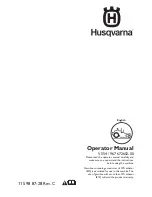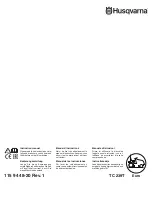
- 12 -
7.3 OPERATION PROCEDURES
During operation, tightly hold the brake handle with both hands.
Note: During operation, when the brake handle is released, the engine will stop and thus stopping the lawnmower from operating.
7.4 TO STOP ENGINE
CAUTION:
The blade continues to rotate for a few seconds after the engine is shut off.
1. Release the brake control handle to stop the engine and blade. (
Fig.
11)
2. Disconnect and ground the spark plug wire as instructed in the separate engine manual to prevent accidental starting while
equipment is unattended.
Fig.
11
7.5 CONNECTION FOR AUTO DRIVE
– SELF PROPELLED
The mower is equipped with a speed adjusting system which allows for 4 speeds of mowing, from 3.0km/h to 4.5 km/h.
Position 4: the slowest position; Position 1: the fastest position. (
Fig.
12A)
Follow the steps below:
1. Release the self-drive control handle and wait for the mower to stop driving forward.
2. Adjust the appropriate speed which you want.
3. Hold the self-drive control handle to continue with the powered drive.
Fig.
12A
Fig.
12B
CAUTION:
your mower is designed to cut normal residential grass of a height no more than 250mm.
Do not attempt to mow through unusually tall dry or wet grass (e.g., pasture) or piles of dry leaves. Debris may build up on the
mower deck or contact the engine exhaust presenting a potential fire hazard.
7.6 FOR THE BEST RESULTS WHEN MOWING
Clear lawn of debris
: Be sure that the lawn is clear of stones, sticks, wire or other objects, which could be accidentally thrown
out by the mower in any direction and cause serious injury to the operator and others as well as damage to property and
surrounding objects.
Avoid cutting wet grass:
For effective mowing do not cut wet grass, because it tends to stick to the underside of the deck
preventing proper mowing of the grass clippings.
General Recommendations:
Cut no more than 1/3 the length of the grass. The recommended cut for mowing is 1/3 the length
of the grass. Ground speed will need to be adjusted so the clippings can be dispersed evenly into the lawn. For especially heavy
cutting in thick grass it may be necessary to use one of the slowest speeds in order to get a clean well mowed cut. When mowing
long grass you may have to cut the lawn in two passes, lowering the blade another 1/3 of the length for the second cut and
perhaps cutting in a different pattern than was used the first time. Overlapping the cut a little on each pass will also help to clean
up any stray clippings left on the lawn. The mower should always be operated at full throttle to get the best cut and allow it to do





































